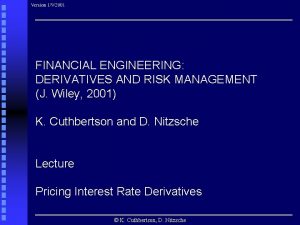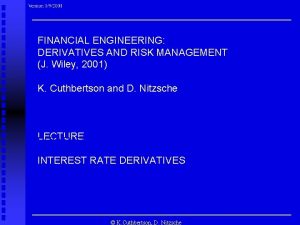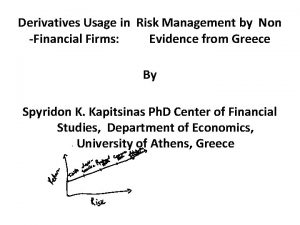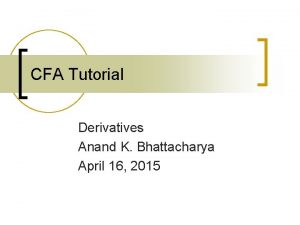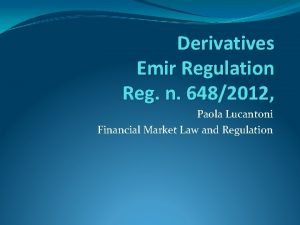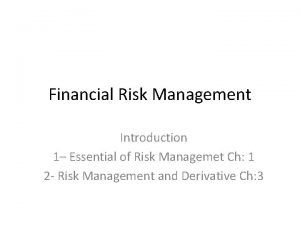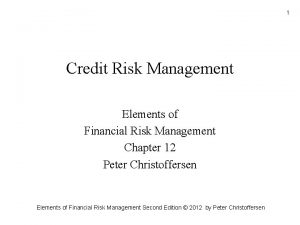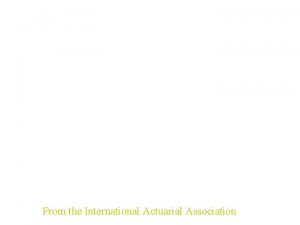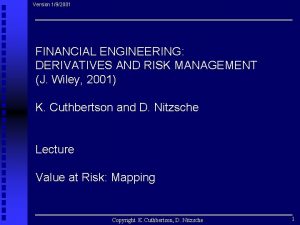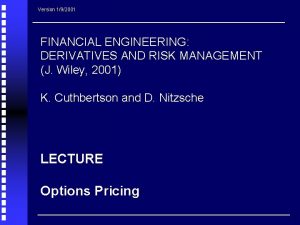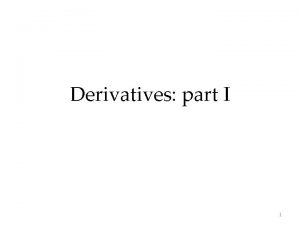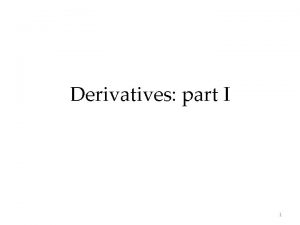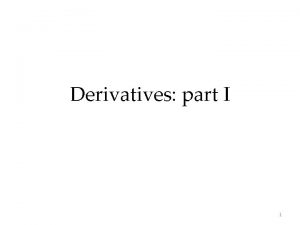192001 FINANCIAL ENGINEERING DERIVATIVES AND RISK MANAGEMENT J





![Static Hedge, Stock+Put (Protective Put) At expiration: [13. 6 a] [13. 6 b] VT Static Hedge, Stock+Put (Protective Put) At expiration: [13. 6 a] [13. 6 b] VT](https://slidetodoc.com/presentation_image_h/f2f7a362acef35c93a2344a12743ba4f/image-6.jpg)



![Dynamic Portfolio Insurance: Algebra Stock+Put [13. 15] N 0 = V 0 /(S 0 Dynamic Portfolio Insurance: Algebra Stock+Put [13. 15] N 0 = V 0 /(S 0](https://slidetodoc.com/presentation_image_h/f2f7a362acef35c93a2344a12743ba4f/image-10.jpg)
![Dynamic Portfolio Insurance: Algebra Stock+T-Bill Portfolio [13. 26] VS, B = NS S + Dynamic Portfolio Insurance: Algebra Stock+T-Bill Portfolio [13. 26] VS, B = NS S +](https://slidetodoc.com/presentation_image_h/f2f7a362acef35c93a2344a12743ba4f/image-11.jpg)







- Slides: 18

1/9/2001 FINANCIAL ENGINEERING: DERIVATIVES AND RISK MANAGEMENT (J. Wiley, 2001) K. Cuthbertson and D. Nitzsche LECTURE Portfolio Insurance ©K. Cuthbertson and D. Nitzsche 1

Topics Static Hedge, Stock-Put (Protective Put) Dynamic Portfolio Insurance ©K. Cuthbertson and D. Nitzsche 2

Static Hedge: Stock+Put (Protective Put) ©K. Cuthbertson and D. Nitzsche 3

Static Hedge, Stock+Put (Protective Put) stock+put = {+1, +1} plus {-1, 0} = {0, +1} September: S&P 500, S 0 = 280 (zp = $500) December-280, S&P 500 put option, P 0 = 2. 97 (index units) Cost of one put option = zp. P = $500 (2. 97) = $1, 485 Value of stocks underlying put option = zp. S =$140, 000 For $1, 250 the put is a claim on $140, 000 of the index (ie. P 0/S 0 = 0. 89%). Number of units of the index held is : [13. 1] N 0* = V 0/S 0 = 2, 000 (ie. 2, 000 -dollars per unit of the index) ©K. Cuthbertson and D. Nitzsche 4

Static Hedge, Stock+Put (Protective Put) Number of units of the index held in stocks: [13. 1] N 0* = V 0/S 0 = 2, 000 (ie. $2, 000 per unit of the index) We need to pay for the puts We hold an equal number N 0 (index units) in stocks and puts: [13. 2] V 0 = N 0 (S 0 + P 0) ©K. Cuthbertson and D. Nitzsche 5
![Static Hedge StockPut Protective Put At expiration 13 6 a 13 6 b VT Static Hedge, Stock+Put (Protective Put) At expiration: [13. 6 a] [13. 6 b] VT](https://slidetodoc.com/presentation_image_h/f2f7a362acef35c93a2344a12743ba4f/image-6.jpg)
Static Hedge, Stock+Put (Protective Put) At expiration: [13. 6 a] [13. 6 b] VT = N 0 ST if ST K(Upside potential) VT = N 0 ST + N 0 (K - ST) = N 0 K if ST < K(Insured level) Net profit = VT - N 0 P 0 ‘Insured’ lower value at: [13. 7] Vmin = N 0 K = 1, 979 (280) = $554, 120 Let ST = 310 Value of insured portfolio = VT = N 0 ST = 1, 979 (310) = $614, 490 Value of uninsured portfolio = N 0*S = 2, 000 (310) = $620, 000 Upside capture is 98. 95% (= $614, 513/$620, 000) ©K. Cuthbertson and D. Nitzsche 6

Dynamic Portfolio Insurance ©K. Cuthbertson and D. Nitzsche 7

Dynamic Portfolio Insurance Matches the price movement of a Stock+Put (protective put) with either Stock + Futures portfolio or Stock+T-Bill portfolio these are ‘replication portfolios’ ©K. Cuthbertson and D. Nitzsche 8

Why use the Replication Portfolios ? ·the hedging horizon of pension funds and mutual funds may be long stock index puts then have to be rolled over may be costly ·most traded stock index options are American and their premia reflect the early-exercise premium Portfolio managers with fixed hedging horizons are reluctant to bear this cost ·position limits (set by the clearing house) may prevent portfolio managers setting up their optimal hedged position in stock index puts. ©K. Cuthbertson and D. Nitzsche 9
![Dynamic Portfolio Insurance Algebra StockPut 13 15 N 0 V 0 S 0 Dynamic Portfolio Insurance: Algebra Stock+Put [13. 15] N 0 = V 0 /(S 0](https://slidetodoc.com/presentation_image_h/f2f7a362acef35c93a2344a12743ba4f/image-10.jpg)
Dynamic Portfolio Insurance: Algebra Stock+Put [13. 15] N 0 = V 0 /(S 0 +P 0) N 0 is fixed throughout the hedge. At t > 0 ‘stock+put’ portfolio: [13. 16] Vs, p = N 0 (S + P), and Stock + Futures N 0* = V 0 / S 0 N 0* is also held fixed throughout the hedge. At t > 0: [13. 19] VS, F = N 0* S + Nf (F zf) and Hence: ©K. Cuthbertson and D. Nitzsche 10
![Dynamic Portfolio Insurance Algebra StockTBill Portfolio 13 26 VS B NS S Dynamic Portfolio Insurance: Algebra Stock+T-Bill Portfolio [13. 26] VS, B = NS S +](https://slidetodoc.com/presentation_image_h/f2f7a362acef35c93a2344a12743ba4f/image-11.jpg)
Dynamic Portfolio Insurance: Algebra Stock+T-Bill Portfolio [13. 26] VS, B = NS S + NB B Equate d. V of stock+put with stock+T-bill ©K. Cuthbertson and D. Nitzsche 11

Example : Portfolio Insurance Value of stock portfolio S&P 500 index Maturity of Derivatives Risk free rate CompoundDiscount Factor Standard deviation S&P V 0 = $560, 000 S 0 = 280 T - t = 0. 10 r = 0. 10 p. a. (10%) er (T – t) = 1. 01 = 0. 12 Put Premium Strike Price Put delta (Call delta) P 0 = 2. 97 (index units) K = 280 p = -0. 38888 ( c = 1 + p = 0. 6112) Futures Price (t=0) Price of T-Bill F 0 = S 0 er(T – t ) = 282. 814 B = Me-r. T = 99. 0 ©K. Cuthbertson and D. Nitzsche 12

Example : Portfolio Insurance Hedge Positions Number of units of the index held in stocks = V 0 /S 0 = 2, 000 index units Stock-Put Insurance N 0 = V 0 / (S 0 + P 0) = 1979 index units Stock-Futures Insurance Nf = [(1979) (0. 6112) - 2, 000] (0. 99/500) = - 1. 56 (short futures) Stock+T-Bill Insurance No. stocks = 1979 (0. 612) = 1, 209. 6 (index units) NB = 2, 235. 3 (T-bills) ©K. Cuthbertson and D. Nitzsche 13

Example : Portfolio Insurance Scenario : Fall of 1 unit in the index, S = -1 hence S 1 = 280 – 1 =270 New Derivatives Prices Put premium P = 3. 377 (using Black Scholes) Futures F 1 = S 1 er(T-t) = 279 ( 1. 01) = 281. 804 (Approx)Change in Put Premium DP = p ( S ) = 0. 38888 Change in Futures Price DF = 281. 804 – 282. 814 = -1. 01 ©K. Cuthbertson and D. Nitzsche 14

Example : Portfolio Insurance 1) Stock+Put Portfolio Gain on Stocks = N 0. DS = 1979 ( -1) Gain on Puts = N 0 DP = 1979 ( 0. 388) Net Gain = -1, 979 = 790. 3 = -1, 209. 6 2) Stock + Futures Dynamic Hedge Gain on Stocks = Ns, o DS = 2000 (-1) = -2, 000 Gain on Futures = Nf. DF. zf = (-1. 56) (-1. 01) 500 = +790. 3 Net Gain = -1, 209. 6 ©K. Cuthbertson and D. Nitzsche 15

Example : Portfolio Insurance 3) Stock + T-Bill Dynamic Hedge Gain on Stocks = Ns DS = 1209. 6 (-1) Gain on T-Bills (No change in T-bill price) Net Gain = -1, 209. 6 = 0 = -1, 209. 6 The loss on the replication portfolios is very close to that on the stock-put portfolio (over the infinitesimally small time period). ©K. Cuthbertson and D. Nitzsche 16

Example : Portfolio Insurance Problems We are only “delta hedging” and hence if there are large changes in S or changes in then our calculations will be inaccurate (ie. Actual change in put premium will not equal that calculated using P = p ( S ) = 0. 38888 ) When there are large market falls, liquidity may “dry up” and it may not be possible to trades quickly enough at quoted prices (or at any price !). ©K. Cuthbertson and D. Nitzsche 17

End of Slides ©K. Cuthbertson and D. Nitzsche 18
 Financial engineering derivatives and risk management
Financial engineering derivatives and risk management Financial engineering derivatives and risk management
Financial engineering derivatives and risk management Financial engineering derivatives and risk management
Financial engineering derivatives and risk management Key risk indicators template
Key risk indicators template Business risk vs financial risk capital structure
Business risk vs financial risk capital structure Market risk credit risk operational risk
Market risk credit risk operational risk Financial management chapter 8 risk and return
Financial management chapter 8 risk and return Non financial derivatives
Non financial derivatives St x
St x Paola lucantoni
Paola lucantoni Securitization
Securitization Risk map risk management
Risk map risk management Risk management irrelevance proposition
Risk management irrelevance proposition Elements of credit risk management
Elements of credit risk management Financial risk management syllabus
Financial risk management syllabus Enterprise risk management for financial institutions
Enterprise risk management for financial institutions Financial risk management conference 2018
Financial risk management conference 2018 Financial management framework
Financial management framework Systematic attempt to specify threats to project plan
Systematic attempt to specify threats to project plan

